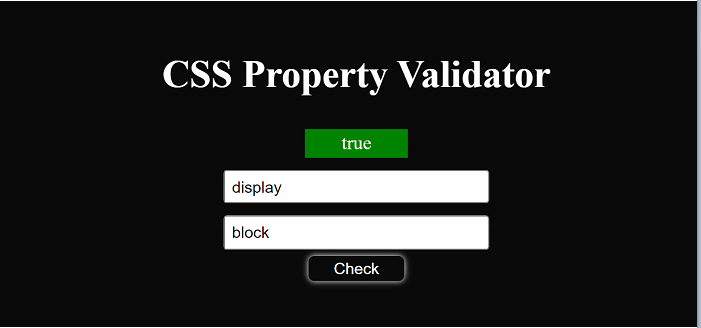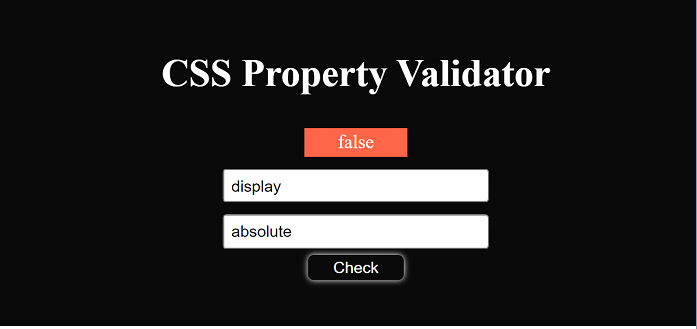How to check if a browser supports a CSS property using JavaScript?
Overview
In today’s world, there are various browsers available on the system. Therefore, sometimes some Cascading Style Sheets (C.S.S.) properties don't work on this browser. So, to check which CSS properties are supported by a particular browser, JavaScript has a built-in method CSS.supports() which checks whether the browser supports that particular property. The supports() method is supported in all browsers: Opera, Edge, Chrome, and Firefox.
grammar
CSS.supports() method takes key-value pairs as input, which are in string format. The basic syntax used is -
CSS.supports(“propertyName:value”);
supports() - This is a method of the CSS object that checks whether the browser supports the property passed in the supports parameter.
propertyName - This contains the name of the CSS property such as display, position, margin, padding, z-index, text alignment, etc.
value - It takes the value of a specific property, such as flex, absolute, relative, 20 px, left, right, etc.
So, to learn more about CSS.Supports() method, we will learn through some examples.
Method 1 - In this example, we will pass the CSS style key value directly as a parameter to the CSS.supports() method, which will then determine whether the given CSS property is available for the browser server support.
algorithm
Step 1 - Use the supports() method that exists within the CSS object as CSS.supports().
Step 2 - Pass any Cascading Style Sheets (CSS) properties as parameters.
Step 3 - Use console.log() to print the CSS.supports() method in the console.
Step 4 - If true is returned when passing an attribute, then that particular attribute is supported, otherwise the browser does not support it.
Example
<!DOCTYPE html>
<html lang="en">
<head>
<title>Check CSS property exist in browser using js</title>
</head>
<body>
<h1>Open console to see result by pressing (ctrl + shift + i) or F12 on keyboard</h1>
<script>
console.log(CSS.supports("float:top"));
console.log(CSS.supports("float:right"));
console.log(CSS.supports("float:bottom"));
console.log(CSS.supports("float:left"));
</script>
</body>
</html>
Output
The output of the above code is shown in the figure below. Since the "float:top" and "float:bottom" properties are invalid, they will return false in the console, while the "float:right" and "float:left" properties will return false if they are valid and supported by the browser. true.

Method 2 - In this method we will build a user interface where users can enter CSS properties in given fields and can check if their browser or browsers support these CSS Attributes. no.
algorithm
Step 1 - Create a two search box, one for keys and one for values since CSS properties are in key-value form. Assign their specific IDs as "propertyName" and "pval" respectively. Create another output field and an HTML button.
Step 2 - Create a function called checkCss() in JavaScript. Arrow functions will be used.
Step 3 - Access the two input boxes and store them in variables, concatenate the values of these boxes into the variables.
Step 4 - Pass this concatenation variable in CSS.supports() and check the if-else condition.
Step 5 - If true is returned, the CSS property is supported, otherwise false is returned, the property is not supported.
Example
<!DOCTYPE html>
<html lang="en">
<head>
<title>Check CSS property exist in browser using js</title>
<style>
body{
min-height: 90vh;
display: flex;
place-content: center;
flex-direction: column;
text-align: center;
background-color: #0a0a0a;
color: white;
}
input{
width:13rem;
margin: 5px auto;
padding: 0.3rem;
outline: none;
}
button{
width: 5rem;
margin: 0 auto;
padding: 0.2rem;
cursor: pointer;
background-color: transparent;
box-shadow: 0 0 5px white;
border-radius: 5px;
color: white;
border: none;
}
</style>
</head>
<body>
<h1>CSS Property Validator</h1>
<div id="output" style="width:5rem;margin: 5px auto;padding: 0.2rem;"></div>
<input type="text" id="propertyName" placeholder="Enter propertyName*">
<input type="text" id="pval" placeholder="Enter value*">
<button onclick="checkCss()">Check</button>
<script>
checkCss = () => {
var p = document.getElementById("propertyName").value;
var v = document.getElementById("pval").value;
var pv = p + ":" + v;
if(CSS.supports(pv)){
document.getElementById("output").innerText=CSS.supports(pv);
document.getElementById("output").style.background="green";
document.getElementById("output").style.color="white";
} else {
document.getElementById("output").innerText=CSS.supports(pv);
document.getElementById("output").style.background="tomato";
document.getElementById("output").style.color="white";
}
}
</script>
</body>
</html>
Output
The output of the above code is as shown in the figure below. Users can type CSS properties in the given input box and check whether your browser supports these properties. As shown in the figure below, the "display:block" attribute is supported by the browser. and is valid, it returns true.

The output is as shown in the figure below. False is returned, so the attributes filled in the input box are invalid and are not supported by the browser.

in conclusion
The return type of thesupports() method is Boolean because it returns true or false depending on whether the current browser supports the CSS property. The Example 2 interface is particularly useful for developers because it eliminates the need to repeatedly check the console; simply enter your CSS property name and value into the input fields and you will be informed whether the current browser supports it.
The above is the detailed content of How to check if a browser supports a CSS property using JavaScript?. For more information, please follow other related articles on the PHP Chinese website!

Hot AI Tools

Undresser.AI Undress
AI-powered app for creating realistic nude photos

AI Clothes Remover
Online AI tool for removing clothes from photos.

Undress AI Tool
Undress images for free

Clothoff.io
AI clothes remover

Video Face Swap
Swap faces in any video effortlessly with our completely free AI face swap tool!

Hot Article

Hot Tools

Notepad++7.3.1
Easy-to-use and free code editor

SublimeText3 Chinese version
Chinese version, very easy to use

Zend Studio 13.0.1
Powerful PHP integrated development environment

Dreamweaver CS6
Visual web development tools

SublimeText3 Mac version
God-level code editing software (SublimeText3)

Hot Topics
 1666
1666
 14
14
 1425
1425
 52
52
 1327
1327
 25
25
 1273
1273
 29
29
 1253
1253
 24
24
 JavaScript Engines: Comparing Implementations
Apr 13, 2025 am 12:05 AM
JavaScript Engines: Comparing Implementations
Apr 13, 2025 am 12:05 AM
Different JavaScript engines have different effects when parsing and executing JavaScript code, because the implementation principles and optimization strategies of each engine differ. 1. Lexical analysis: convert source code into lexical unit. 2. Grammar analysis: Generate an abstract syntax tree. 3. Optimization and compilation: Generate machine code through the JIT compiler. 4. Execute: Run the machine code. V8 engine optimizes through instant compilation and hidden class, SpiderMonkey uses a type inference system, resulting in different performance performance on the same code.
 Python vs. JavaScript: The Learning Curve and Ease of Use
Apr 16, 2025 am 12:12 AM
Python vs. JavaScript: The Learning Curve and Ease of Use
Apr 16, 2025 am 12:12 AM
Python is more suitable for beginners, with a smooth learning curve and concise syntax; JavaScript is suitable for front-end development, with a steep learning curve and flexible syntax. 1. Python syntax is intuitive and suitable for data science and back-end development. 2. JavaScript is flexible and widely used in front-end and server-side programming.
 From C/C to JavaScript: How It All Works
Apr 14, 2025 am 12:05 AM
From C/C to JavaScript: How It All Works
Apr 14, 2025 am 12:05 AM
The shift from C/C to JavaScript requires adapting to dynamic typing, garbage collection and asynchronous programming. 1) C/C is a statically typed language that requires manual memory management, while JavaScript is dynamically typed and garbage collection is automatically processed. 2) C/C needs to be compiled into machine code, while JavaScript is an interpreted language. 3) JavaScript introduces concepts such as closures, prototype chains and Promise, which enhances flexibility and asynchronous programming capabilities.
 JavaScript and the Web: Core Functionality and Use Cases
Apr 18, 2025 am 12:19 AM
JavaScript and the Web: Core Functionality and Use Cases
Apr 18, 2025 am 12:19 AM
The main uses of JavaScript in web development include client interaction, form verification and asynchronous communication. 1) Dynamic content update and user interaction through DOM operations; 2) Client verification is carried out before the user submits data to improve the user experience; 3) Refreshless communication with the server is achieved through AJAX technology.
 JavaScript in Action: Real-World Examples and Projects
Apr 19, 2025 am 12:13 AM
JavaScript in Action: Real-World Examples and Projects
Apr 19, 2025 am 12:13 AM
JavaScript's application in the real world includes front-end and back-end development. 1) Display front-end applications by building a TODO list application, involving DOM operations and event processing. 2) Build RESTfulAPI through Node.js and Express to demonstrate back-end applications.
 Understanding the JavaScript Engine: Implementation Details
Apr 17, 2025 am 12:05 AM
Understanding the JavaScript Engine: Implementation Details
Apr 17, 2025 am 12:05 AM
Understanding how JavaScript engine works internally is important to developers because it helps write more efficient code and understand performance bottlenecks and optimization strategies. 1) The engine's workflow includes three stages: parsing, compiling and execution; 2) During the execution process, the engine will perform dynamic optimization, such as inline cache and hidden classes; 3) Best practices include avoiding global variables, optimizing loops, using const and lets, and avoiding excessive use of closures.
 Python vs. JavaScript: Community, Libraries, and Resources
Apr 15, 2025 am 12:16 AM
Python vs. JavaScript: Community, Libraries, and Resources
Apr 15, 2025 am 12:16 AM
Python and JavaScript have their own advantages and disadvantages in terms of community, libraries and resources. 1) The Python community is friendly and suitable for beginners, but the front-end development resources are not as rich as JavaScript. 2) Python is powerful in data science and machine learning libraries, while JavaScript is better in front-end development libraries and frameworks. 3) Both have rich learning resources, but Python is suitable for starting with official documents, while JavaScript is better with MDNWebDocs. The choice should be based on project needs and personal interests.
 Python vs. JavaScript: Development Environments and Tools
Apr 26, 2025 am 12:09 AM
Python vs. JavaScript: Development Environments and Tools
Apr 26, 2025 am 12:09 AM
Both Python and JavaScript's choices in development environments are important. 1) Python's development environment includes PyCharm, JupyterNotebook and Anaconda, which are suitable for data science and rapid prototyping. 2) The development environment of JavaScript includes Node.js, VSCode and Webpack, which are suitable for front-end and back-end development. Choosing the right tools according to project needs can improve development efficiency and project success rate.




